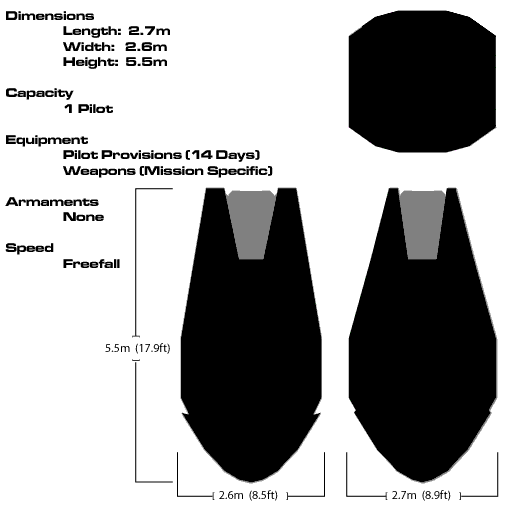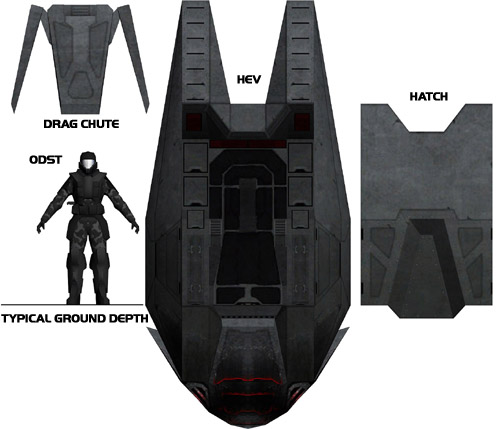
Human Entry Vehicle (HEV)
Article by Stephen Loftus [SoundEffect], images by Dojorkan and SoundEffect.

Overview
The UNSC Marines' orbital insertion pod, the HEV, is more technically known as an SOEIV (Single Occupant Exo-atmospheric Insertion Vehicle). It's a rocket-propelled drop capsule vehicle designed to maximize the number of troops to successfully make stealth incursions into enemy territory from orbit. It is, however, a hazardous ride to the surface: it's common knowledge beyond even the Marines that volunteer for service in the ODST outfit that during all drop operations, a certain percentage are unlikely to make it down alive. They are a fiercely loyal and committed group; admired by many in the UNSC. HEV pods are assigned to individual ODSTs, and each pod is individually named for its occupant.
If a traditional troop-deployment method was used where landing zone intelligence was either lacking (or was in known hostile territory), a single dropship, such as a Pelican, could take enemy fire and all troops could be lost in one shot. With the HEVs, ODSTs can deploy to the surface in numbers equal to a traditional drop method, yet enhance their chances of success by presenting an enemy with multiple small targets rather than one larger one.

HEV pods are mounted in special slanted alcoves on board specially equipped UNSC ships. The ship's computer is responsible for determining launch trajectory, initial deploy velocity, etc. The HEV is released from clamps that hold it above its launch chute. The main hatch of the HEV unlatches and slides upwards. When latched, it is hermetically sealed to contain occupant atmosphere, and keep the hazardous outside atmosphere and temperatures out.
All thumbs lead to full-sized images
 |
 |
 |
| HEV drop bay onboard UNSC frigate | HEV with open hatch | ODST with HEV |
The HEV occupant compartment can house one soldier, and has compartments for weapons, ammunition, and survival provisions for a 2-week period. When a ship disengages an HEV, it is not simply dropped, but is rather accelerated out of its launch chute and is propelled safely away from the ship.
 |
 |
 |
| Spartan-117 ready for drop | HEV uncouples from In Amber Clad | HEV pod drops through chute |
After the pod leaves the vicinity of its ship, it is in freefall towards a planet's surface. The bottom of the HEV is covered in an ablative ceramic skin, more protective than the ceramic skin around the remainder of the vehicle. The pod's crew compartment, during its burn through the atmosphere, can reach as high as 37°C (98°F); enough to be mildly uncomfortable to the already suited-up ODST.
Part of the pod's deceleration is initially reliant on the inertial drag caused by the air of the planet. After the vehicle has slowed sufficiently, a braking chute is deployed on a strong tether a few meters above the pod. It's made of the same metals and ceramics as the rest of the pod. It's not meant to be a parachute to slow the vehicle significantly, but rather as a way of stabilizing the pod during its decent so the retro-thrusters can fire at the proper angle to slow the craft.
 |
 |
 |
| HEV enters the atmosphere | Freefall heats up HEV | Braking Chute deploys |
The HEV pod contains an onboard computer. The platoon commander's HEV is specially equipped with a UNSC AI construct to assist with tactical decisions and landing coordination with the other pods in the drop. At almost the same time as the drag chute deploys, powerful retro-thrusters ignite below the HEV to cause significant deceleration. This is the last such measure the pod utilizes before actual impact with the planet's soil. As soon as the retro-thrusters fire and begin to accelerate the pod, the drag chute is automatically detached from the pod. The thrusters slow the HEV to the point where impact would not be overly harmful to the occupant. Once the pod is on the surface, explosive bolts blast the formerly hermetically sealed hatch away from the pod, allowing the soldier to commence ground operations.
 |
 |
 |
| HEV computer and viewscreen | HEV retro-thrusters slow descent | HEV makes landfall |